Dec 16, 2015
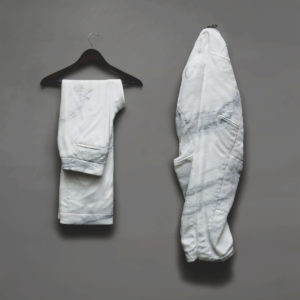
We Both Wear Pants, marble, 43 x 36 x 4 in.
This piece is both portrait and admission.
It comes from the same place as a series of pieces I began years ago. Yours, Mine & Ours, was my attempt to visually describe the unique personalities that make up my family. My wife is the smooth, folded bath towel to my rumpled heap of terry cloth. Another piece, Shed, focused on the business casual work attire donned by my wife on a daily basis.
This recent piece goes much farther in being honest about a fairly large aspect of our lives: work. The smooth, satin, carefully folded material on the slacks-specific clothes hanger are in stark contrast to my rough and rumpled work pants which, when not in use, are usually found slung on a hook in a locker with the work belt still in the belt loops. This pretty well describes our unique work situations.
The fact that my wife’s stable career has allowed me to develop in a much less structured way as an independent artist is pretty much constantly on my mind. While I have been extremely fortunate, having received a degree of critical acclaim and financial success that I never would have expected, none of these achievements have represented anything that approaching riches. I grew up in a household where my father was the primary “bread winner” and my mother took care of most everything else.[nggallery id=73]
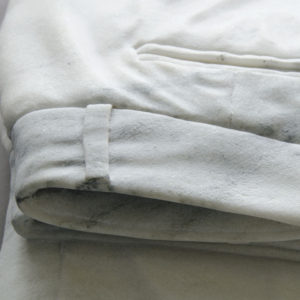
We Both Wear Pants, marble, 43 x 36 x 4 in.
I must admit that I feel shame and a sense of personal failure that I have not even come close to reaching the point where I could say to my wife: “Hey, I’ve got this. You don’t need to work to support this family.” She wouldn’t want to stop working if she could; she loves what she does, however, I would like to be able to give her that option. At present, I cannot do that. While we might earn approximately the same number of dollars per year– hers come on a consistent basis and with health insurance and other benefits that my sporadic, commission-based, freelance, sub-contractor income completely lacks.
Like the stone itself, relationships can be hard, and require a lot of work. They are both enduring and fragile at the same time. And they are worth the effort. Individuals are often dissimilar, though they work.
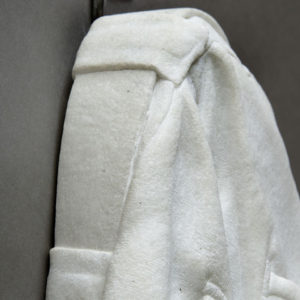
We Both Wear Pants, marble, 43 x 36 x 4 in.
Jokes and comments are often made regarding who wears the pants in a given relationship. Many people have a this idea that being a stone carver is a very “macho” endeavor, but from my perspective, not really. First off, there are fair few extremely successful female stone sculptors out there. Secondly, there isn’t anything much more traditionally masculine than being able to fully financially support one’s own family . . . So, I can’t really agree with the stereotype. I’m not being overly modest. I love the tradition and physicality of the work I do, and I think that I can make some neat stuff. I am a handy and all. However, if one was going to ask who wears the pants in our family– well, it certainly wouldn’t be me alone.
In our case, I’d say that I have received far more of the benefit from our work together than she. Her stability, organization, reliability, and care have allowed me to have a much more chaotic, irresponsible and unstable career path than the average person. I’m the dirty laundry. I’m very thankful to have been able to hang my rumpled, coarseness next to her smooth, silkiness for many years now, and hopefully for many more.
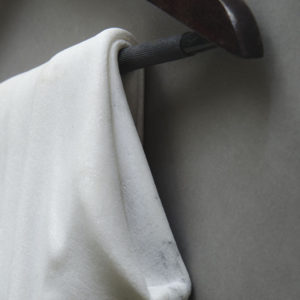
We Both Wear Pants, marble, 43 x 36 x 4 in.
Jun 18, 2015
BmoreArt
June 18, 2015
By Cara Ober
It’s rare to find a contemporary sculptor skilled in the ancient craft of carving marble. It’s even more rare to find one in Baltimore. This is one of the reasons that Sebastian Martorana’s marble towels, which appear pliable enough to pass for the real thing, hang on the walls of the Walters Art Gallery in Rinehart’s Studio: Rough Stone to Living Marble. Despite living centuries apart, both sculptors followed similar paths in learning their craft and the exhibit is an opportunity to appreciate their similarities and differences, and to understand Rinehart’s legacy in Baltimore.
Although he is now based in Baltimore, Sebastian Martorana grew up in Manassas, VA and received his BFA in illustration from Syracuse University. He also studied sculpture in college and included a semester in Italy. After graduation, he became a full-time apprentice in a stone shop outside of Washington, D.C. before coming to Baltimore to earn his MFA at the MICA’s Rinehart School of Sculpture, founded by the estate of William Henry Rinehart . . .
Please follow this link to read the full article at BmoreArt.
Dec 4, 2014
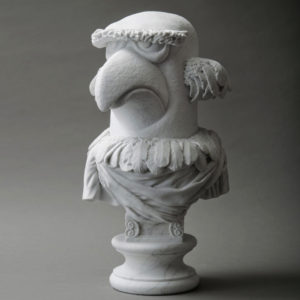
Icon: Sam the Eagle, marble, 19 x 12 x 12 in.
I was recently asked by pair of supportive collectors to revisit a series I began a few years ago.
The latest in the Icon Series is based on, American Icon and Muppet, Sam the Eagle.
Sam occupies a unique place in the wacky crowd that is the Muppets. He stands in as the ironic voice of conservatism and reason against the backdrop of frenetic chaos.
Some of my first memories of the Muppets involve Sam as a disgruntled participant in the Tit Willow song, deadpanning the part of the Dicky Bird — I had it on vinyl for my Fisher Price turntable.
I feel that Sam was kind of the vehicle for the writers to speak slyly against censors and non-progressives in a way that was smart, funny, wry satire before The Daily Show and, ultimately, The Colbert Report perfected it.
In a double-headed manner Sam expounds the necessity of “the noble eagle, the good old values, the wisdom of the Founding Fathers” in a way that is seen by certain political groups– albeit with out the irony.
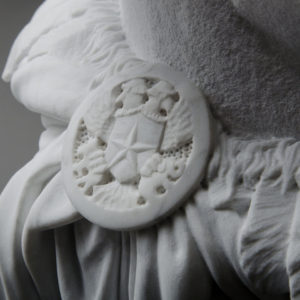
Icon: Sam the Eagle, marble, 19 x 12 x 12 in.
Throughout Sam’s tenure as a kind of disapproving-uncle-figure he avoided ever becoming a villain (more recently playing the role of a hero in the latest Muppet movie). So I chose to depict him in the style of Emperor Hadrian, one of the more benevolent (relatively speaking), if not initially bumbling, rulers of the Roman Empire.
Sam actually appeared for the first time in 1975 in the second Muppet Show: Sex and Violence, the series’ second pilot. Note: in the background, often over Sam’s right shoulder, there is a marble bust that is conspicuously attired with random bits of costuming each time it appears in the shot — hah! Classic!
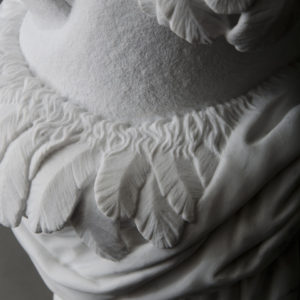
Icon: Sam the Eagle, marble, 19 x 12 x 12 in.
Aug 1, 2014
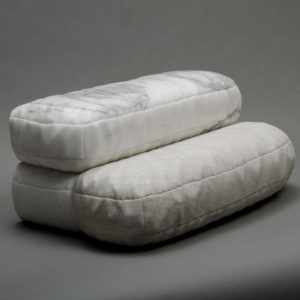
Baby Steps, marble
Obviously, as a kind of extension of the Soft Step Series, I wanted to make a sort of mini-stoop that would be more appropriate for my (then) one year old son.
He loves to stoop with us, but his feet dangle uncomfortably off the full size stair steps.
To be fair, at almost two years old now, he has probably already outgrown the scale of this piece . . .
I thought is doing this when I saw how taken he with a child-size recliner at a house we stayed at on vacation. Why not make a child-size stoop?
Ultimately, we got him his own child-size recliner, chocolate faux-leather. The treads and cheek walls of this piece are made from salvaged pieces of stone from our neighborhood, and the seams and polished finished are based on his little chair.
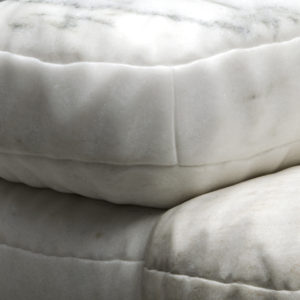
Baby Steps, marble
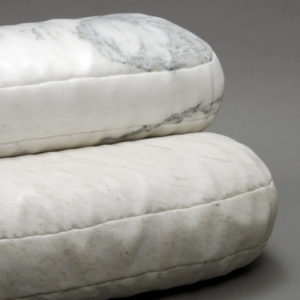
Baby Steps, marble
Jan 8, 2014
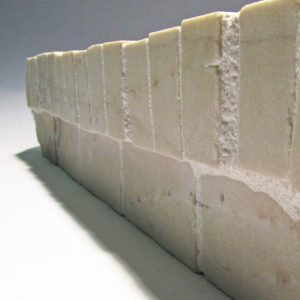
New Construction, marble, 8 x 46 x 14 in.
Ever since I showed the first New Construction piece (the cinder block), people have been telling me: “You should carve a brick! You should carve a brick!”
People are always telling me what I should carve and sometimes they are right. But in this case, honestly–that didn’t sound very interesting. Conceptually it made sense; bricks are another modern material being used to replace what once would have been marble. I am always saddened when I see a set of bricks slapped up where stone steps once existed stoops (particularly those new smooth and perfect bricks that lack any of the charm of the aged and irregular bricks that new-old-homeowners are always exposing). And, more often than not, the bricks aren’t even laid well! And, one or two steps on the outer edges are usually missing or have been re-set at one time or another.
Yet still, “a brick” was still not interesting enough to compel me to just carve one out of stone . . . Then I remembered something that one of my grad school professors, Ming Fay, said during a group crit: “If you are going to do something simple — do a lot of it.”
It then occurred to me that unlike a cinder block, a single brick is not very structurally or sculpturally dynamic, but like a cinder block they are meant to be used in concert. So I decided to just illustrate the thing that I was hoping to speak against: a step made of bricks that was once a step of marble.
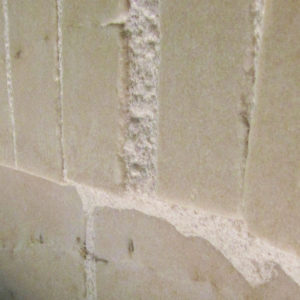
New Construction, marble, 8 x 46 x 14 in.
This proved to be quite a challenge. On one hand this is one of the rawest sculptures that I’ve ever done; the broken edge and the un-finished, roughly tooled interior sides were left un-re-carved. On the other hand, because I was trying to represent a series of nearly perfect and identical objects assembled together imperfectly, the piece was extremely technically demanding. I spent a lot of time removing very small amounts of stone to make sure that right angles were actually right angles. Add to that the fact that this particular stone had a wide vein of some of the hardest minerals present in nature.
It would have actually been far easier to carve a series of bricks that were aligned perfectly rather than a series of bricks that are slightly out of kilter. This is definitely the kind of piece that owes credit to my trainers at Manassas Granite & Marble, Inc. who, during my apprenticeship, instilled the technical skills and discipline of the craft of carving that now allow me the ability to make this kind of sculptural work.
So while one carved brick would probably be pretty lame — I’m hoping that twenty-six carved bricks are not.
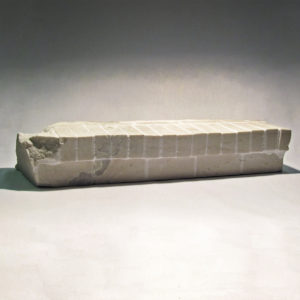
New Construction, marble, 8 x 46 x 14 in.













